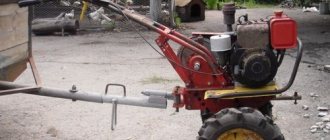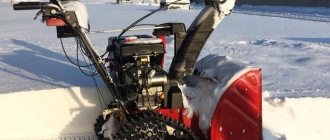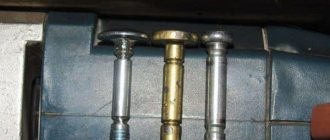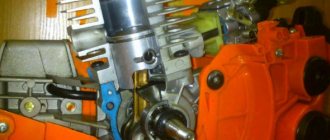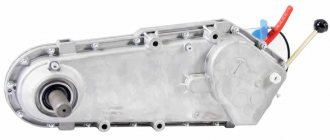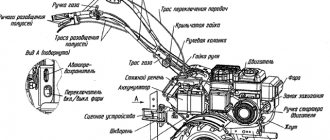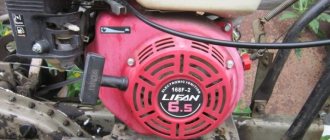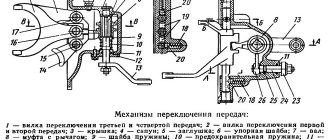No matter how high-quality the equipment for cultivating a summer cottage or garden plot is, it requires good care. Otherwise it may break quickly. Let's talk in this article about how to ensure good care and repair of the cultivator gearbox so that it serves its owners for as long as possible.
What is a gearbox?
Motoblock gearbox design
Like any other mechanism of a walk-behind tractor, the gearbox of an agricultural implement consists of certain elements. Taking into account the type of gearbox, its design can be equipped with certain parts. Basically, the gearbox design in detail looks like this:
- Cover and pulley;
- Bearings;
- Bushings on the input shaft;
- Adjustment and shift lever;
- Shift fork and shaft;
- Gear in the intermediate shaft;
- Shaft block;
- Double-row chain;
- Sprocket block;
- Washers and seals;
- Input shaft;
- Right and left axle shafts;
- Double star;
- Clutch;
- Bracket and spring;
- Clutch fork.
The mechanism diagram below will tell you in more detail how the walk-behind tractor gearbox works.
Despite the rather complex design of the mechanism, its dismantling and reassembly will not raise any questions even for a beginner. To do this you need:
- Completely remove the gearbox from the walk-behind tractor;
- Unscrew the screws and remove the protective covers;
- Carefully remove the bushing on the input shaft, dismantle the lever and fork that switches the mechanism;
- Remove the input shaft and gear from it;
- Remove the shaft bushings and chain;
- Dismantle the shaft block and remove the sprockets from it;
- Remove the intermediate shaft along with the gears;
- Remove the clutch, left and right axle shafts.
After completing all of the above steps, you will receive a disassembled walk-behind tractor gearbox. After repair, the mechanism must be reassembled in reverse order.
Motoblock Tselina
The Tselina equipment is produced by Perm. The company has been operating since 1997. In Perm, “Academy of Tools” is known as a manufacturer of equipment for gardens and park areas; the company has its own factory.
The Tselina brand produces not only walk-behind tractors, but also motor-cultivators, as well as attachments for this equipment. The advantage of the equipment produced is that it can be used in conjunction with other units for the garden, for example, with walk-behind tractors and cultivators Cascade, Neva, Oka, Kadvi, Elitech and others.
The purpose of the produced walk-behind tractors and cultivators "Virgin" is agricultural work of varying complexity, including work in virgin soil, plowing, cultivation, harrowing, hilling, mixing fertilizers with soil; utility work, such as clearing leaves or snow; any transport tasks, both with a trolley and an adapter.
The model range of Tselina walk-behind tractors includes many models - from low-power to powerful, with different engine life. The minimum power of a walk-behind tractor in this series is 4 hp, the maximum is 13 hp. Next, the most popular units will be discussed in more detail.
Main types of cultivators
Before purchasing any cultivator, you need to understand its types and species diversity (capabilities):
- light - used in cultivating land plots with an area of no more than 12 acres. Such cultivators are easy to move because they weigh little (up to 30 kilograms). Perhaps their most significant drawback is that they are not able to cultivate the soil at great depths (the depth should be no more than 20 cm);
- medium - these weigh more (up to 90 kilograms) and can cultivate a larger area (up to 50 acres);
- heavy - this type speaks for itself, these are cultivators weighing more than 90 kilograms. Heavy cultivators have one excellent ability: a variety of additional attachments can be attached to them, which increases the technical capabilities of the unit several times.
According to the type of built-in engine, cultivators are divided into:
- gasoline - their main advantage is reliability during operation, but there is also a disadvantage - the cost of purchasing fuel.
- Electric cultivators are their strong point in simplicity and ease of control. But these units can process not very large areas and not far from the house, since they are dependent on a source of electricity. The length of the power cord plays an important role in their mobility, and for good operation they need a high-quality electrical network - without power surges..
- battery-powered ones are the main “trump card” of these types of cultivators, they are mobility and independence from electricity and any type of fuel (after charging they can work autonomously for a long time).
When choosing a cultivator, always be guided by the area of your plot. For small areas, it’s a good idea to opt for an electric cultivator; by the way, it works very well in greenhouses and flower beds. For a large plot of land, take a gasoline one (medium or heavy type), but immediately stock up on funds to refuel it, or you can take a battery-powered one (however, it is inferior in power to gasoline).
When you buy, be sure to try on the equipment; the handles of the device should be comfortable and made of high-quality material, and their surface should be covered with roughness so that your hands do not slip while operating (especially important in hot weather). All control devices must be visible and easy to use
The main thing is convenience when working with the equipment and further proper care of garden equipment.
Description
Luch walk-behind tractors have come a long way from their creation to the present day. Initially, the manufacturer of these walk-behind tractors was the Perm Motors OJSC enterprise, which in the 90s became part of the Perm engine-building complex.
The units are well-deservedly popular among domestic farmers and have a reputation as powerful, productive, fault-resistant devices with varying capacities. Each owner can choose a walk-behind tractor model based on the site, scope of work, and purpose.
Photo of the Luch MB-1 walk-behind tractor
Features of the Luch walk-behind tractors are as follows:
- affordable price and high build quality;
- attachments suitable for many other domestic and Chinese models;
- endurance, possibility of use in any season;
- ability to work on any type of fuel (gasoline AI-92, AI-76, AI-82 and other types of gasoline);
- almost complete absence of bad reviews about walk-behind tractors (among the positive reviews there are many mentions of endurance, good assembly, reliability and power of the device).
This is interesting: Review of the characteristics of the Lifan walk-behind tractor: we explain in detail
Device
The trimmer gearbox includes 2 shafts - the first is driven by the engine, and the other is used to rotate the cutting blade of the brush cutter or electric trimmer line. Bevel gears are made as a single unit with the shaft, but there are versions with the installation of a separate part on a spline connection. Models are available with different tooth angles, which depend on the layout of the tool. There are modifications of gearboxes with worm, planetary or mixed (multi-stage) gears.
The shafts are mounted on rolling bearings, which are covered with protective washers. The parts ensure the preservation of lubricant and prevent dirt from entering the work paths. The bearings are installed in a gear housing made of aluminum alloy. The unit is detachable and consists of 2 symmetrical halves, which are connected to each other with screws. To ensure the tightness of the joint, a separate gasket or sealant is used.
The lower gearbox for the trimmer is installed on the tool through a mounting socket. There are several types of joints, differing in shape.
There are modifications of the tool with square or polyhedral joints of elements. Torque transmission is carried out through a splined connection.
The lineup
In the model range of Tselina walk-behind tractors there is a division into categories:
- MB category;
- category MB R;
- NMB category.
Tselina also produces a diesel model of the walk-behind tractor - MB-400D. This is one of the most favorite models among farmers, since diesel fuel, according to some reviews, is more economical than gasoline.
Currently, the manufacturer presents on the website in the category of MB walk-behind tractors the following models: MB-501, MB-600, MB-601, MB-602F, MB-700, MB-701, MB-802F, MB-900, MB-901 , MB-1301. The maximum power of walk-behind tractors of this type is 13 hp, the minimum is 5 hp.
The following models are presented in the MB R category: MB-610R, 710R, 910R, 611R, 711R, 911R, 912FR, 812FR, 612FR. Their power ranges from 6 to 9 hp.
The NMB category contains the following models of walk-behind tractors: NMB 601, 901, 903. Their power ranges from 6 to 9 hp.
Distinctive features of Tselina walk-behind tractors:
- gasoline engines “Lifan” (China) or “Vympel” (Russia), with power from 4 to 13 hp;
- There are also devices with diesel engines (MB-400D);
- simple location of key components;
- recognizable design;
- 3 years warranty (latest models);
- some models, for example from the MB-01 series, are equipped with a protective bumper in the front part of the structure;
- all walk-behind tractors are equipped with pneumatic tires with noticeable relief;
- affordable price in comparison with foreign analogues;
- a wide network of dealer and service centers throughout Russia, sales in neighboring countries;
- interchangeability of spare parts on different models.
Tips for use
To increase the service life of the snow blower gearbox, you should carefully read the advice of experienced professionals.
- Always use only high-quality gear oil for lubrication. If you lubricate the device with semi-synthetic analogues, the mechanism will quickly fail.
- Take ten-minute breaks after the snow blower has been running for an hour. This is necessary to ensure that the gearbox does not heat up too much and does not wear out prematurely.
- Clean the assembly regularly. Even when pouring high-quality oil, carbon deposits can accumulate on the walls, interfering with the ideal operation of the mechanism. If you use your snow blower regularly, you should wash it every two weeks.
- Be careful when pressing the auger drive lever. After all, with any pressing of the lever, the drive cable stretches. Therefore, pressing on the wire lever should only be used when absolutely necessary.
- Do not allow oil to leak from the gear housing. Check and replace all seals in a timely manner.
- Always inspect the snow carefully to ensure that foreign objects do not get inside the snow blower. They can damage the gearbox.
To learn how to replace a gear in a snow blower gearbox, watch the video below.
Ignition system repair
Signs of a malfunctioning ignition system:
- With normal fuel supply, the engine does not start. The fuel supply can be checked by removing the spark plug. If it is wet, it means fuel is flowing. Place the connected spark plug on the engine body and vigorously crank the starter. You should see a spark between the electrodes. If it is not there, look for a malfunction in the generator – ignition coil – high-voltage cable chain;
- The engine operates intermittently at idle;
- It may stall at idle.
First, check the condition of the spark plug. If chips, cracks or other damage to the insulator are visible, the spark plug should be replaced.
Check for carbon deposits on the electrodes and adjust the gap.
Inspect the condition of the high-voltage cable and spark plug cap. Very often, the cable is damaged due to overheating or ingress of fuel during refueling. In this case, the “spark” goes through the insulation to the motor body, and the mixture does not ignite.
If everything is in order at this stage, the fault may be in the coil or generator. Connect a measuring device to the generator terminals and rotate the starter pulley as if you want to start a cultivator.
The readings should be between 12-16 volts. Check the cable from the generator to the breaker. If all components are working properly, it means the ignition coil has failed. Replace it, and engine performance will be restored.
How to check the oil in the gearbox of a walk-behind tractor?
Monitor the amount of oil constantly. Otherwise, careless attitude to technology will lead to fatal consequences. Fresh oil is added every 50 hours. Along with this, excessive loads should be avoided, which ultimately lead to the rapid deterioration of mechanisms and components. Let's move on directly to changing the oil:
- We install the equipment on a flat area. We find a probe 70 cm long.
- The dipstick is bent and pushed into the oil fill hole until it stops, after which we remove the rod.
- We observe the oil level, which should be at least 25 cm. Add 2 liters of oil to the dry gearbox, at least 1.5 liters.
How to lubricate the trimmer gearbox
The trimmer gearbox should be lubricated regularly, following the tool manufacturer's recommendations. In this case, it is recommended to apply an antifriction substance to the drive shaft located in the rod. The lubricant is introduced into the cavity of the gearbox housing through a special hole closed with a screw plug. The unit must first be cleaned of dirt. When carrying out repairs and replacing gears or bearings, it is necessary to remove the remaining old oil and add new oil.
Types of lubricants for gearboxes are divided by consistency:
- liquid or semi-liquid;
- plastic;
- hard.
Also, the characteristics of the lubricant depend on the base base:
- Graphite, contains a complex of additives that reduce the risk of scuffing. Has a hard or plastic consistency.
- Lithium, which further reduces corrosion of elements. Belongs to the category of plastic.
- Universal, consisting of mineral oil and a complex of additives. Belongs to the category of liquid or semi-liquid lubricants.
The most widely used lubricants are Litol-24, Champion EP-0, Gear Grease Oregon, as well as their analogues made by other manufacturers. A list of recommended lubricants and their parameters are indicated in the trimmer repair and maintenance instructions.
How often do you encounter problems with the lower gearbox of the trimmer? Can you fix the problem yourself?
Engine malfunctions
There are two main types of malfunctions of this kind - failure of the engine to start and its unsatisfactory operation (interruptions, lack of power, spontaneous stopping).
The engine does not start. If we are talking about a gasoline engine, when troubleshooting, it is necessary to consistently check all possible causes of problems, namely:
- Turn on the ignition.
- Availability of fuel in the tank.
- Opening the fuel tap.
- The condition of the carburetor air damper (it should be closed when starting a cold engine).
- Fuel entering the carburetor. To do this, you need to fill the float chamber by pressing down the float button (fuel should start pouring out of the hole in the float chamber cover), or disconnect the fuel hose from the carburetor and check whether gasoline flows freely. If the fuel flows in too thin a stream or does not flow at all, this may indicate a dirty fuel filter in the tank or a clogged air valve in the tank cap. Repairing a walk-behind tractor in this case will come down to cleaning the filter or valve.
The supply of fuel to the engine cylinder may be indicated by the condition of the spark plug, which in any case must be checked when troubleshooting the ignition system. The spark plug is unscrewed from the cylinder cover, having previously disconnected the wire, and inspected. If it is dry, this means that the fuel mixture is not supplied to the cylinder.
And if before this it was established that gasoline is entering the carburetor, then the reason for the engine not starting may be in the carburetor - contamination of its filter mesh, clogging of the nozzle or some other malfunction.
Whatever it is, the carburetor needs to be removed, disassembled and cleaned, but this device is very complex and before repairing it you should at least look at the carburetor diagram.
Carburetor of Cascade walk-behind tractor
If the spark plug is contaminated with carbon deposits, it should be cleaned with gasoline and fine sandpaper. It is also necessary to check the gap between the electrodes and, if necessary, adjust it in accordance with the requirements of the operating manual. Typically the gap should be about 0.8mm.
After this, you need to check for the presence of a spark - attach a wire to the spark plug, press its metal part to the cylinder cover and simulate starting the engine with a starter. If the spark plug is working properly, a spark will occur between the electrodes. Sometimes it happens that a spark occurs, but it is so weak that it is not enough to ignite the fuel. If you have doubts about the strength of the spark, you need to check the operation of the engine with a new spark plug.
The absence of a spark may mean a faulty spark plug, lack of contact in the electrical circuit, a violation of the gap between the ignition coil and the magnetic circuit, or a malfunction of the electronic ignition coil. All these elements must be checked. A faulty spark plug and ignition coil must be replaced.
If the walk-behind tractor is equipped with an electric starter, the engine may not start due to a discharged battery, a blown fuse, or a faulty starter. You need to check the battery charge, replace the fuse, repair or replace the starter.
The engine does not develop power. If the walk-behind tractor engine starts but does not develop power (runs intermittently, stalls or does not gain speed under load), the following malfunctions may be possible reasons for unsatisfactory operation.
The air filter is dirty, resulting in insufficient air entering the carburetor, and the fuel mixture is over-rich. Proper maintenance of a walk-behind tractor involves periodically cleaning the air filter, however, very dusty work may require more frequent cleaning.
It is necessary to check the condition of the air filter and, depending on its material, clean it using one of the appropriate methods. The paper filter is cleaned by lightly tapping it on something hard and blowing it with a vacuum cleaner, the foam filter is washed in water with detergent and dried, the mesh filter is blown with a vacuum cleaner, etc.
When the filters reach the end of their service life, they must be changed.
Air filter for SunGarden walk-behind tractor
Low quality fuel. Bad fuel must be replaced with one recommended by the manufacturer.
Sometimes the engine cannot develop power due to the muffler being clogged with combustion products. In this case, you need to disassemble the muffler and check its condition, if necessary, wash it in gasoline and clean it with a car wash to remove carbon deposits using detergents.
The non-removable muffler is dried with a hairdryer after washing. Remember that carbon deposits contain substances that are carcinogens, and dry cleaning, which could result in their inhalation, is unacceptable. When removing the muffler, plug the engine exhaust hole with a clean rag.
Dirty or incorrect adjustment of the walk-behind tractor carburetor. It is necessary to remove and clean the carburetor, and then adjust it, if this is provided for in the walk-behind tractor instructions.
A drop in engine power can be caused by a decrease in compression due to wear of the cylinder-piston group, the formation of scoring and scratches on the cylinder and piston, “retraction” in the grooves or breakage of the piston rings. In this case, check the compression by connecting a compression gauge to the spark plug hole and turning the engine shaft with the starter.
Normal compression is characterized by a value of at least 8 atm (normal compression can be indicated in the engine characteristics). When measuring it, you need to take into account that the presence of a decompressor in the engine can affect the readings of the compression meter. The compression value in this case is about 5 atm.
will not mean a low degree of wear of the cylinder-piston group, but the operation of the decompression valve.
The diesel engine does not start. For most users, repairing and tuning a walk-behind tractor with a diesel engine is a more difficult task than repairing a walk-behind tractor with a gasoline engine. Not so much, perhaps, because of the design complexity of the diesel engine, but because of the lack of experience, since household devices are usually equipped with gasoline engines.
Diesel walk-behind tractor
The most common faults or conditions that may prevent diesel engines from starting are outlined in the table below. A detailed list of diesel malfunctions and methods for eliminating them are set out in the operating instructions for specific diesel walk-behind tractors.
| Cause | Remedy |
| The weather is too cold. | Pour hot water into the radiator. |
| The fuel has frozen and lost its fluidity. | Use the correct grade of fuel or heat it up. |
| The nozzle is clogged. | Clean or replace the nozzle. |
| Insufficient injection pressure. | Adjust pressure. |
Insufficient cylinder compression (engine cranks too easily with starter).
|
|
Problems and solutions
If during operation of the device, the summer resident notices increased noise in the gearbox, you should immediately stop the cultivator:
First you need to establish the cause of this phenomenon. Experts say that noise in the gearbox occurs due to a lack of oil. Also, a similar problem can be caused by a discrepancy in the quality of the oil used in terms of its brand and purity. For example, if an inexperienced farmer poured old gasoline or fuel of questionable quality into the fuel tank of the unit. In the first case, you should simply add oil to the cultivator gearbox to the optimal level. In the second - change its brand;
Transmission components can also make noise. This occurs due to poor tightening of fasteners. Carefully inspect the device and tighten them if necessary;
In many cases, noise is caused by worn gears and bearings. If this is the reason, the farmer should be wary of more serious damage. However, problems with the device will not arise if the cultivator gearbox is repaired in a timely manner. And it consists in dismantling and replacing parts that have become unusable.
If the soil cultivation equipment does not turn on at all, if it is turned off randomly or if switching speeds is accompanied by difficulties, the farmer should think about the following reasons:
Parts that are involved in the gear shifting process may have worn out. Often, such wear occurs at the ends of the engaged gears, which leads to problems when changing the speed of the machine. In such conditions, it will be necessary to dismantle the worm gearbox of the cultivator and straighten the gear teeth by grinding. If the wear is irreversible, these parts of the device must be replaced;
- The shaft splines may have worn out or the shafts may have moved axially due to wear on the bearings and retaining rings. To adjust the axial position of the shafts, you will need to install additional locking rings. If the wear of the bearings and rings is too severe, they should be replaced;
- The farmer has adjusted the clutch incorrectly, which can lead to difficulty changing gears. This may occur due to the inexperience of the operator who releases the clutch lever in advance when changing gears. In this situation, you will need to adjust the clutch and learn how to change gear correctly and in a timely manner.
If transmission components overheat, it is worth checking the bearings for wear. Also, the cause of such problems can be an insufficient amount of transmission oil in the crankcases, as well as its poor quality. In such conditions, the main measures for repairing the land cultivation product will be as follows:
- replacing worn bearings;
- Change of oil.
If a cultivator worm gearbox is installed on a product for cultivating land, and the farmer notices an oil leak from this unit, then he should check the seals of the bearing units for correct installation.
Let's sum it up
The cultivator gearbox is a complex assembly that can be worm or chain. Its features must be taken into account by the farmer during its operation. You need to understand when it is worth changing the oil or using a product such as lubrication of the cultivator gearbox, otherwise breakdowns cannot be avoided. The next video will tell you how to properly repair a cultivator chain gearbox with your own hands.
What is a gearbox?
The gearbox is one of the main components of the cultivator drive for soil cultivation. It can be chain or worm. The reliability level of a given unit determines the operational life of the equipment and the need for its repair.
Look at the following photo to understand what the mole cultivator gearbox looks like visually.
Economy class units are often equipped with a non-separable type gearbox, the service life of which is not particularly long. It is important to note that this type of unit cannot be repaired or disassembled. Its parts are not sleeved and are of low quality.
More expensive options have collapsible gearboxes in their design. They can be maintained: if the spare parts of such a gearbox wear out, they can be replaced. For example, bushings or bearings must be replaced.
If the cultivator becomes unusable for any reason, the damage will need to be repaired. There are special services that provide similar services. However, if a summer resident does not want to overpay, if repairs need to be completed as quickly as possible, or if he sees himself as strong and has the skills, he can repair the soil treatment equipment himself.
What kind of breakdowns happen?
In most cases, problems in the walk-behind tractor gearbox arise due to overloads. Such breakdowns include bursting of bushings on a metal chain, which leads to the so-called “slippage”. Also, owners of walk-behind tractors very often find broken gear shift bushings. To avoid such troubles, experienced owners advise changing gears only when the equipment is completely stopped, and never while moving. In addition, star breakage is considered a common phenomenon. That is, factory welding is not enough for the star to withstand overloads.
It’s very easy to “get out” of this annoying situation; you just need to return the star to its original position and secure it with much better welding. Lateral loads lead to wear of the support washer, after which the bushings fly off the chain. In addition to all of the above, it is necessary to periodically check the oil level in the gearbox and also replace it.
Varieties
The gearboxes with which walk-behind tractors are equipped seem identical only at first glance. In fact, these devices can be divided into three groups. The differences lie in the design features of the gearboxes. Let's get to know the representatives of this family in more detail.
Angular
Angle-type gearboxes are elementary structures that serve to connect the transmission to the power plant of the unit.
Due to the absence of complex components, some farmers install homemade versions of angular gearboxes on walk-behind tractors.
The structure of this node looks like this:
- Mechanism body.
- Belt drive pulley with fastening.
- Rotor shaft.
- Flange complete with mounting and bearing.
- Washer and fixing key.
Gear
This is a more complex mechanism, which is impossible to recreate at home without special skills and knowledge.
Gear reducers are called reduction gearboxes. Thanks to its design features, the mechanism reduces the engine speed, simultaneously increasing the power output of the walk-behind tractor.
Such gearboxes have a long service life, so they are suitable for performing various jobs, and do not suffer mechanical damage even under peak loads.
Unlike angular models, reduction gearboxes require additional cooling.
Reversible
This mechanism is based on a clutch that moves freely between bevel gears.
Such gearboxes enable the walk-behind tractor to move in reverse, which has a positive effect on the maneuverability of the equipment.
However, this comes at the cost of reduced performance and maximum speed. Therefore, each farmer decides independently whether to install a reversible gearbox or not.
Gearboxes installed on walk-behind tractors from different manufacturers have virtually no design differences. Therefore, disassembling the unit and replacing failed parts will not cause difficulties.
The exception is budget walk-behind tractors made in China. A non-separable gearbox is installed here, which in case of breakdown can be replaced entirely.
Installation of a homemade or replacement mechanism
- If you plan to operate the cultivator as intensively as possible, angle energy converters should be used. But such a device is suitable only if the transmission and motor are connected through a chain. Reduction gearboxes (aka speed reducers) are installed only in conjunction with air-cooled engines.
- It is recommended to weld the housings of homemade devices from steel plates. In some cases, heavy truck shafts (like the Ural) are used instead.
- Launching homemade energy converters is done in exactly the same way as when using similar industrial designs. The first starts should not be carried out under high load.
To learn how to make a reduction gearbox without turning, see the video below.
No matter how high-quality the equipment for cultivating a summer cottage or garden plot is, it requires good care. Otherwise it may break quickly. Let's talk in this article about how to ensure good care and repair of the cultivator gearbox so that it serves its owners for as long as possible.
What is a gearbox?
Engine system malfunctions during startup
If, when checking the spark plugs, they turn out to be wet, i.e. fuel flows normally, but the engine does not start, the problem may be the following:
- there is a characteristic carbon deposit on the electrodes of the spark plugs (it is necessary to clean the spark plugs with emery, after which they should be washed with gasoline and dried);
- the gap between the electrodes does not correspond to those specified by the manufacturer in the engine operating manual (the gap is adjusted by bending the side electrode to the required dimensions);
- the insulators of the spark plugs or high-voltage electrical wiring are damaged (faulty spark plugs and wiring must be replaced);
- the STOP button is shorted to ground (for normal engine starting, the short circuit must be eliminated);
- the contacts in the spark plug brackets are broken (the contacts should be put in order);
- the gap between the magnetic shoe and the starter does not correspond to the standard value (the gap needs to be adjusted);
- Defects were detected on the stator of the ignition system (the stator must be replaced).
- Air leaks through carburetor seals, spark plugs, plug and cylinder heads, as well as carburetor and engine cylinder connections.
If depressurization of connections is detected, it is necessary to tighten the mounting bolts, tighten the spark plugs and check the integrity of the gaskets between the spark plug heads and the cylinders.
- Incomplete closing of the carburetor air damper.
To eliminate this problem, it is necessary to ensure free movement of the damper by monitoring the quality of the drive. If jams are detected, they must be eliminated.
Compression failure and carburetor problems
It happens that the launch is carried out, but the process is significantly difficult. At the same time, the engine of the walk-behind tractor is extremely unstable and cannot develop sufficient power for normal operation.
The reason for this may be loss of compression, which can be identified by:
- carbon deposits on the working surfaces of valves, as well as cylinder block seats;
- intake valve deformation;
- wear of piston rings.
In order to restore compression, you must:
- Check the technical condition of the engine gas distribution mechanism, clean the parts contaminated with carbon deposits, and if there are defects, replace them.
- Check the condition of the piston rings and replace faulty components.
If during engine operation black smoke comes out of the muffler, and excess oil is detected on the electrodes of the spark plugs or they themselves are covered with soot, this means that:
- a supersaturated fuel mixture is supplied to the carburetor;
- the sealing of the carburetor fuel valve is broken;
- the piston oil ring is worn out;
- The air filter is clogged.
To resolve this issue you should:
- adjust the carburetor;
- replace a leaky valve;
- replace worn piston rings;
- Clean or replace the faulty air filter.
If, when the engine is running, light smoke comes out of the muffler, and the electrodes of the spark plugs are dry and covered with a white coating, this means that a lean fuel mixture is entering the carburetor. This problem is eliminated by adjusting the carburetor.
How to fill oil into a walk-behind tractor gearbox
Before pouring new oil into the gearbox, you need to drain the old fluid. This is exactly how the oil is changed in the gearbox of the Salyut walk-behind tractor, a video of which can be found on the Internet, as well as other models of walk-behind tractors.
The algorithm of actions will be as follows:
- The walk-behind tractor needs to be installed on some hill so that the oil can be easily drained from the gearbox.
- There are two plugs on the gearbox - a drain plug, which is located at the bottom of the gearbox, and a plug that closes the oil filling hole. First, unscrew the filler plug, which is located on top of the walk-behind tractor body (at the gearbox).
- We take a sufficiently capacious container (an old bottle of transmission oil will do), and then place it under the gearbox drain plug.
- Carefully unscrew the drain plug, after which the oil will begin to flow into our container. After waiting until the oil has completely drained, screw the drain plug back in. Then tighten it with a spanner of a suitable diameter until it stops.
Oil filling process
- Insert the funnel into the filling hole. Then we take the appropriate gear oil to fill the gearbox.
- Having filled the reducer to the optimal level, screw the plug back. This plug is equipped with a special dipstick, and its length is approximately 10 cm. After we have filled in the oil, we need to check its level. To do this, we tighten this plug-dipstick, after which we unscrew it again and check it.
- If the oil is at the tip of this dipstick, then there is no need to add any more.
As a rule, the oil change procedure must be performed every 100 hours of operation of the walk-behind tractor. In some cases, this procedure must be performed every 50 hours.
In other words, the frequency of oil changes depends on the model of the walk-behind tractor, so all the necessary information is in the accompanying documentation for the walk-behind tractor.
